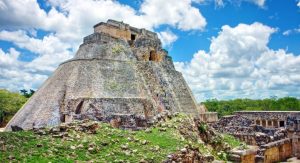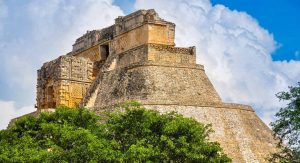Introduction — Have You Heard of the “Other” Mayan Wonder?
hen people think of Mayan ruins in Mexico, Chichen Itza usually steals the spotlight. But let me share a secret — if you’ve only visited Chichen Itza, you’ve missed one of the most breathtaking archaeological experiences the Yucatán has to offer: Uxmal Travel Guide.
Nestled in the Puuc region of Yucatán, Uxmal feels different. It’s grand without being overcrowded, intricate without being over-commercialized, and magical in a way that photos can never fully capture. Here, the sound of your footsteps echoes through ancient plazas, and the artistry of carved stone tells stories from over a thousand years ago.
In this guide, we’ll explore everything you need to know about visiting Uxmal — its fascinating history, must-see highlights, insider tips, cultural context, and practical advice. By the time you’re done reading, you’ll be ready to explore these incredible ruins like a pro.
What Is Uxmal and Why Does It Matter?

Uxmal is one of the most important Mayan archaeological sites in Mexico. Dating back to around 700–1000 AD, it was a major center in the Puuc region and is now recognized as a UNESCO World Heritage Site.
The Meaning of the Name
The name “Uxmal” is often translated as “thrice built” — hinting at the multiple phases of construction the city underwent. It reflects both the resilience and sophistication of the Mayan builders who continually improved and expanded their city.
Why It’s Special
Unlike many other Mayan cities, Uxmal wasn’t laid out according to a strict geometric plan. Instead, its buildings are harmoniously integrated into the surrounding hills, creating a natural flow through plazas and ceremonial centers.
A Brief History of Uxmal
To appreciate Uxmal fully, it helps to understand its historical backdrop.
- Rise (circa 700 AD): Uxmal grew as a political and cultural powerhouse during the Late Classic period, controlling trade routes and agricultural production in the Puuc hills.
- Peak (900–1000 AD): Population may have reached 20,000. Monumental buildings like the Pyramid of the Magician and the Nunnery Quadrangle were constructed.
- Decline: Like many Mayan cities, Uxmal eventually fell into decline, possibly due to drought and political shifts. By the time the Spanish arrived, it was largely abandoned.
- Rediscovery: Archaeological work in the 19th and 20th centuries brought Uxmal’s grandeur back into public awareness.
Architectural Style — The Beauty of Puuc Design
Uxmal is the crown jewel of the Puuc architectural style. What makes it unique?
- Smooth limestone walls with intricate mosaic friezes at the top.
- Geometric stone patterns — checkerboards, lattice designs, and step-frets.
- Chaac masks — depictions of the Mayan rain god, repeated over doorways and corners.
- Long, low palaces arranged around central courtyards.
- Minimal use of tall pyramids compared to other Mayan sites.
This attention to artistic detail is why many travelers find Uxmal visually more beautiful than other ruins in Mexico.
Must-See Highlights at Uxmal

1. Pyramid of the Magician
The most iconic structure in Uxmal — unusual for its oval base and steep sides. Legend says it was built overnight by a dwarf magician, giving it an air of mystery.
Insider Tip: Visit early in the day when the sun casts dramatic shadows across its curved façade.
2. Nunnery Quadrangle
Despite its name, this was not a convent but a set of four grand buildings forming a ceremonial complex. Its decorative friezes are among the finest in all Mayan architecture.
3. Governor’s Palace
A long, elegant building set on a massive platform, famous for its elaborate stone mosaics and panoramic views of the site.
4. Great Pyramid
Climb to the top (if permitted) for sweeping views of Uxmal’s layout and the surrounding jungle.
5. Ball Court
Where the ancient Mesoamerican ball game was played — a ritual that had deep political and religious meaning.
The Experience — What Visiting Uxmal Feels Like
Walking through Uxmal is unlike visiting more crowded tourist sites.
- Quiet Pathways: You can pause and take in the details without being rushed.
- Birdsong and Breeze: Nature feels close; you may spot iguanas sunning themselves on the stones.
- Connection to the Past: The artistry and engineering make you wonder how such structures were built without modern tools.
How to Get to Uxmal
Uxmal is located about 80 km (50 miles) south of Mérida, making it an easy day trip.
Transportation Options:
- By Car: The most flexible way to visit, especially if you want to explore nearby Puuc Route sites.
- Bus Tours: Many Mérida-based operators include Uxmal in day trip itineraries.
- Public Bus: Budget-friendly but less flexible in timing.
Best Time to Visit Uxmal
- Morning: Cooler temperatures and softer light for photography.
- Late Afternoon: Golden light makes the stone carvings glow.
- Season: November to March offers the most pleasant weather. May through September can be hot and humid.
What to Bring
- Lightweight, breathable clothing
- Hat and sunglasses
- Comfortable walking shoes
- Reusable water bottle
- Camera or phone with plenty of storage
- Sunscreen (preferably eco-friendly)
Benefits of Visiting Uxmal
- Less Crowded: Compared to Chichen Itza, you can explore at your own pace.
- Architectural Masterpieces: The Puuc style is arguably the most elegant of all Mayan designs.
- Rich Cultural Insights: Carvings and layouts reveal deep Mayan beliefs.
- Proximity to Other Sites: Kabah, Sayil, and Labná are all nearby.
Common Misconceptions
- “Uxmal is just like any other Mayan ruin.”
Not true — the Puuc style is distinct, and the preservation here is exceptional. - “You can skip Uxmal if you’ve seen Chichen Itza.”
Uxmal offers a completely different feel — less commercial and more serene. - “There’s nothing around Uxmal.”
The surrounding Puuc Route is packed with other archaeological gems.
Mistakes to Avoid
- Arriving midday without shade or water — the heat can be intense.
- Rushing through without a guide or reading plaques — you’ll miss the deeper meaning of the carvings.
- Only visiting the main pyramid — many treasures are in the details of smaller buildings.
Tips for Making the Most of Your Visit
- Hire a local guide for richer storytelling.
- Combine your visit with the Puuc Route to see other Mayan sites in the area.
- Visit during a weekday to avoid weekend crowds.
- Take time to study the Chaac masks — each one is slightly different.
Industry Trends — Uxmal in Modern Tourism
- Sustainable Tourism Initiatives: Efforts are underway to preserve the ruins and limit over-tourism.
- Cultural Revivals: Events and festivals bring Mayan traditions back to life on-site.
- Digital Guides: Augmented reality apps are emerging to show reconstructions of how the city once looked.
Frequently Asked Questions (FAQs)
Q: How much time should I spend at Uxmal?
A: Plan for at least 2–3 hours to see the main highlights without rushing.
Q: Can I climb the structures?
A: Some are open for climbing, but rules can change for preservation reasons.
Q: Is Uxmal family-friendly?
A: Yes, but keep in mind there’s little shade and lots of walking.
Q: Are there food options nearby?
A: Yes, there are small restaurants and snack stands near the entrance.
Q: Is Uxmal accessible for people with mobility challenges?
A: Terrain is uneven, and there are steps, so it can be challenging.
Final Thoughts — Why Uxmal Should Be on Your Bucket List
If you want to experience the magic of the Mayan world without the crowds, Uxmal is your place. It’s more than just ruins — it’s a living testament to creativity, resilience, and human connection with nature.
Here, history feels close enough to touch. The carvings tell stories, the plazas invite exploration, and the stones hold the warmth of the sun and centuries of memory. Whether you’re a history buff, a photographer, or simply curious about Mexico’s past, Uxmal will leave you inspired.
So next time you’re in Yucatán, take the road less traveled. Uxmal is waiting — and it’s ready to amaze you.
